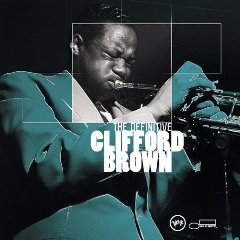Clifford Brown - The Definitive Clifford Brown (2002)
Clifford Brown - The Definitive Clifford Brown (2002)

01. Easy Living (3:43) 02. Wee Dot (7:00) 03. Jordu (7:45) 04. I Get a Kick Out of You (7:42) 05. Joy Spring (6:50) 06. Daahoud (4:04) 07. I've Got You Under My Skin (5:23) 08. He's My Guy (4:13) 09. Born to Be Blue (5:17) 10. Stardust (3:26) 11. Cherokee (5:47) 12. I'll Remember April (9:15) 13. The Scene Is Clean (6:05) Clifford Brown - Composer, Primary Artist, Trumpet Danny Bank - Sax (Baritone) Joe Benjamin - Bass Keter Betts - Bass Art Blakey – Drums Lou Donaldson - Sax (Alto) Maynard Ferguson - Trumpet Barry Galbraith - Guitar Herb Geller - Sax (Alto) Gigi Gryce - Flute, Sax (Alto) Roy Haynes - Drums Percy Heath - Bass Milt Hinton - Bass Osie Johnson - Drums Jimmy Jones - Piano Harold Land - Sax (Tenor) John Richard Lewis - Piano Junior Mance - Piano Herbie Mann - Flute Helen Merrill - Vocals George Morrow - Bass Richie Powell - Arranger, Piano Paul Quinichette - Sax (Tenor) Max Roach – Drums Sonny Rollins - Sax (Tenor) Charlie Rouse - Sax (Tenor) Curly Russell - Bass Horace Silver - Piano Clark Terry - Trumpet Sarah Vaughan - VocalsVocals
Trumpeter Clifford Brown had a brief career. He started playing jazz in the late '40s but was killed in a car accident in 1956 (along with pianist Richie Powell, younger brother of Bud). In that short time his interest in expanding the bebop medium is apparent on The Definitive Clifford Brown. Several of the legendary hard bop quintet sides he recorded with Max Roach for Emarcy are featured as well as his warm tone mixing beautifully with string arrangements and backing up vocalists Helen Merrill, Dinah Washington, and Sarah Vaughan. The Definitive Clifford Brown is a well rounded introduction providing a glimpse into the full spectrum of a career cut tragically short. --- Al Campbell, AllMusic Review
When Verve launched its Definitive series in 2002, the producers seemed to be faced with an embarrassment of riches. When one considers the possibilities, there is so much classic jazz material from the 1950’s and 1960’s that it would be impossible to pin down the greatest recorded sessions from those decades, let alone creating a set of CD’s that could be called "definitive." But Richard Seidel set himself to the task of choosing the most important recordings by artists who were available through their activity on Blue Note and Verve, and so artists who recorded on, say, Columbia, like Miles Davis or Thelonious Monk, are not represented in the Definitive series of reissued recordings.
In the case of Clifford Brown, the process of researching and compilation may not be as hard as it seems, especially when compared to the "definitive" recordings of McCoy Tyner, for example, who is still shaping his own legend by continuing to record. Some creations of Brown’s imagination, such as his composition, "Joy Spring," have become indelible additions to the jazz canon, so much so that Jon Hendricks put words to his and Harold Land’s solos.
In addition, Brown’s years of recording activity were foreshortened by his death on the Pennsylvania Turnpike in June 0f 1956. So, the choices for inclusion in The Definitive Clifford Brown are not as extensive as they would be for Sonny Rollins, who recorded with Brown in Max Roach’s quintet after Land moved back to California. That’s not to say that they aren’t effective, though, for Clifford Brown cast a long shadow over the jazz scene, leaving those who heard him agog at his talent.
The Definitive Clifford Brown covers in chronological order some of Brown’s best-known recordings, starting with the first recording he led with Art Blakey and John Lewis, "Easy Living," in 1953. Despite the overflowing energy of Blakey’s group, which the drummer generated throughout his career, Brown found his place in jazz history when he joined Max Roach in 1954, and their Los Angeles recordings, after Land joined the quintet there, became some of their most well known. Not only that, but the jam session with Dinah Washington that followed the studio dates for Clifford Brown and Max Roach became justifiably famous for the availability of top-notch musicians from Roach’s group, Maynard Ferguson’s band and Duke Ellington Orchestra. Represented by "I’ve Got You Under My Skin" on The Definitive Clifford Brown, that session includes Brown’s breakaway trumpet session after the Latin rumble of Washington’s first time through the song. But also it includes a young and powerful Ferguson trading choruses with the equally powerful, but in his own style, Brown.
After a middle section of Brown’s recordings with Sarah Vaughan and Helen Merrill to the more conventional studio band arrangements by Ernie Wilkins and Quincy Jones, The Definitive Clifford Brown concludes with some of Brown’s final sessions with Max Roach’s quintet that included Sonny Rollins--and Richie Powell, who died in the same automobile crash with Brown.
The Definitive Clifford Brown provides a short lesson in the fact that neither age (for Clifford Brown was only 25 when he died) nor length of career is a vital ingredient in the importance of an artist’s influence. Rather, the fertility of ideas and the ability to communicate inspirationally with an audience, as exemplified by Brown’s talent, are what count. --- Don Williamson, jazzreview.com
download (mp3 @320 kbs):








